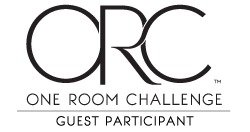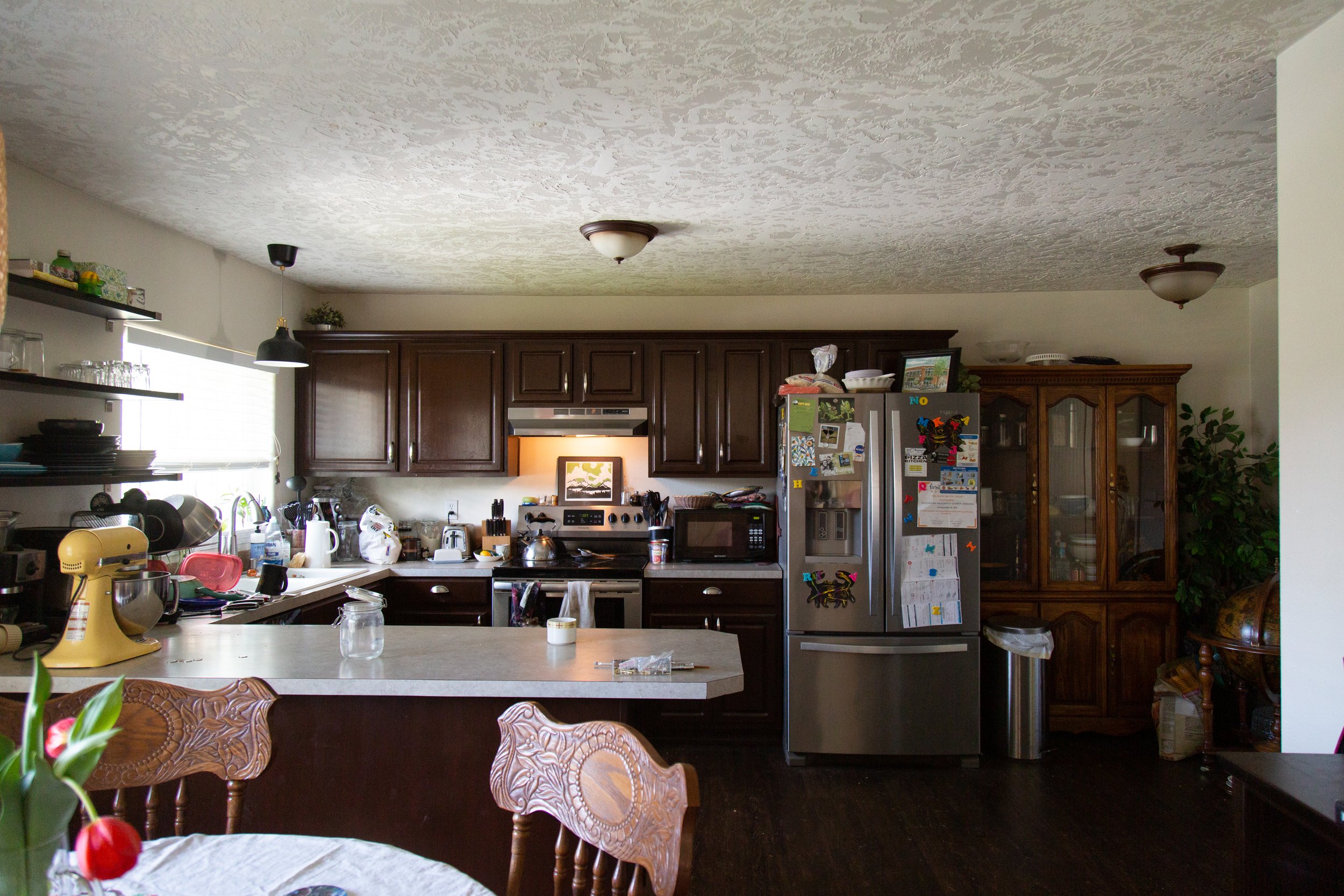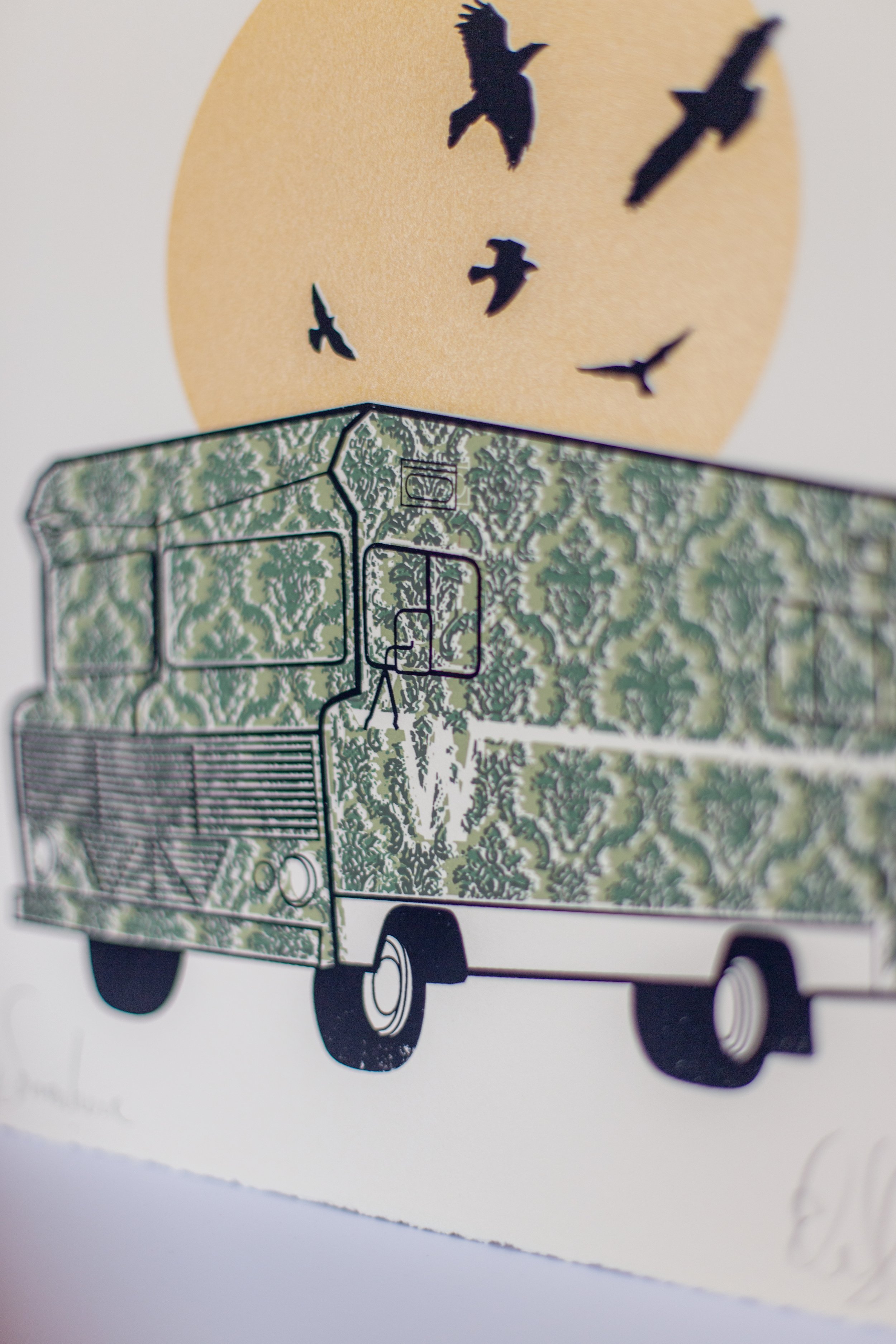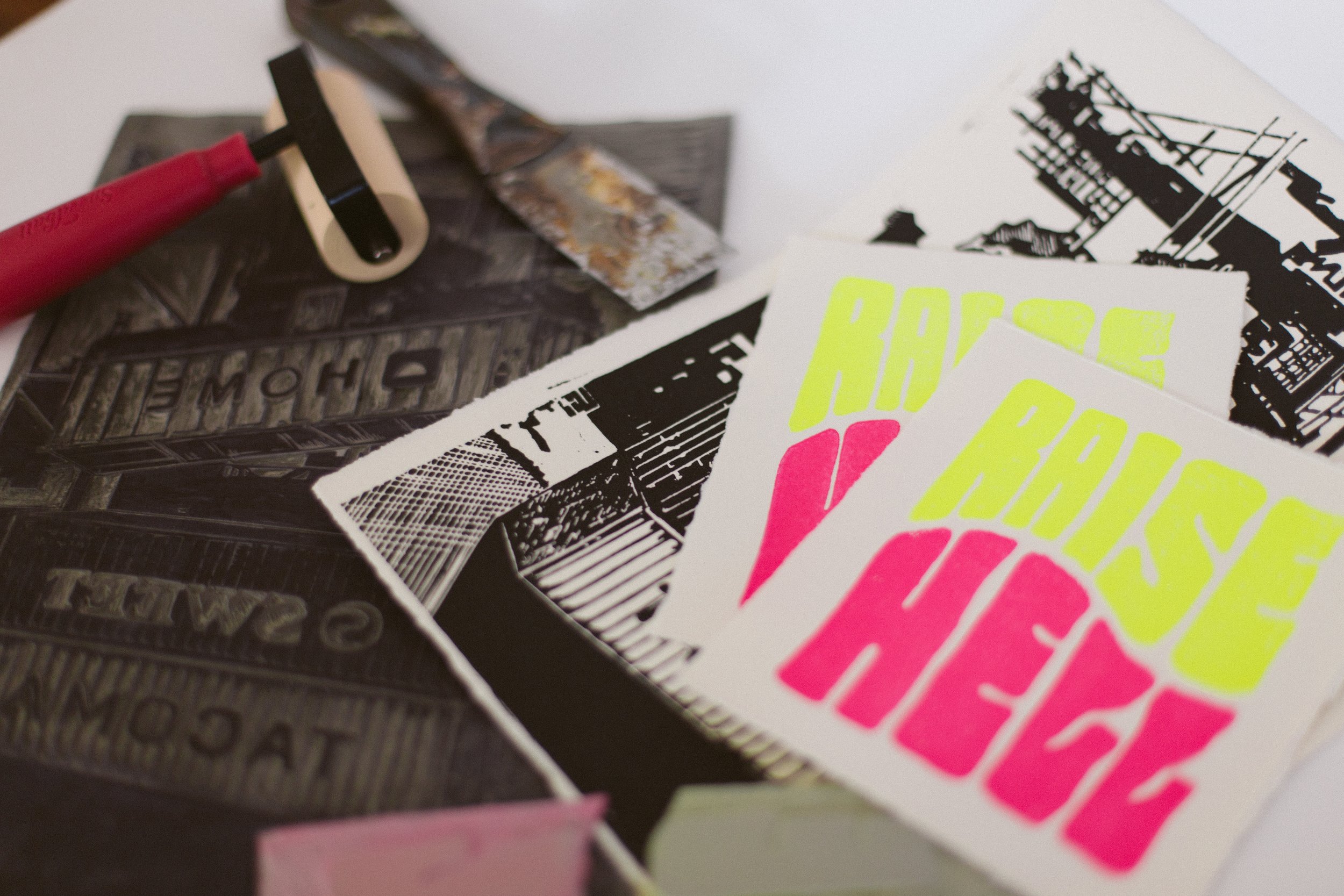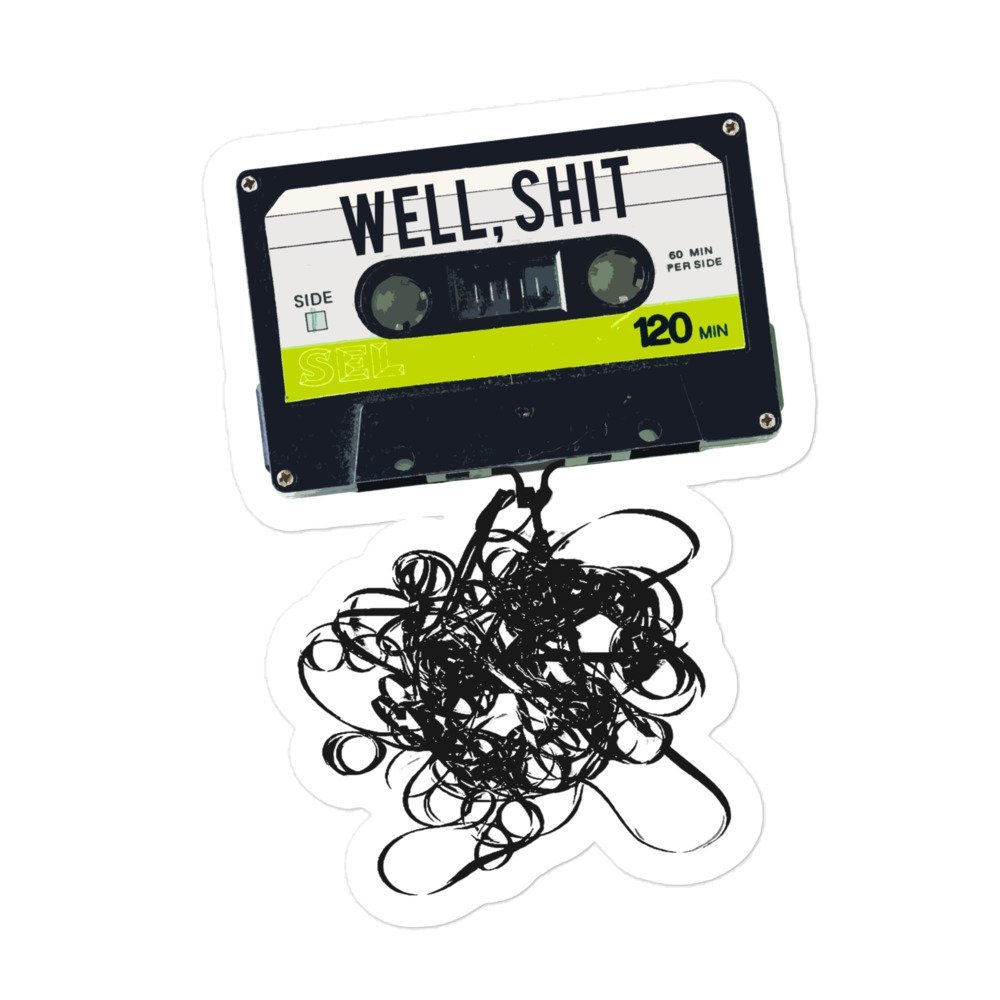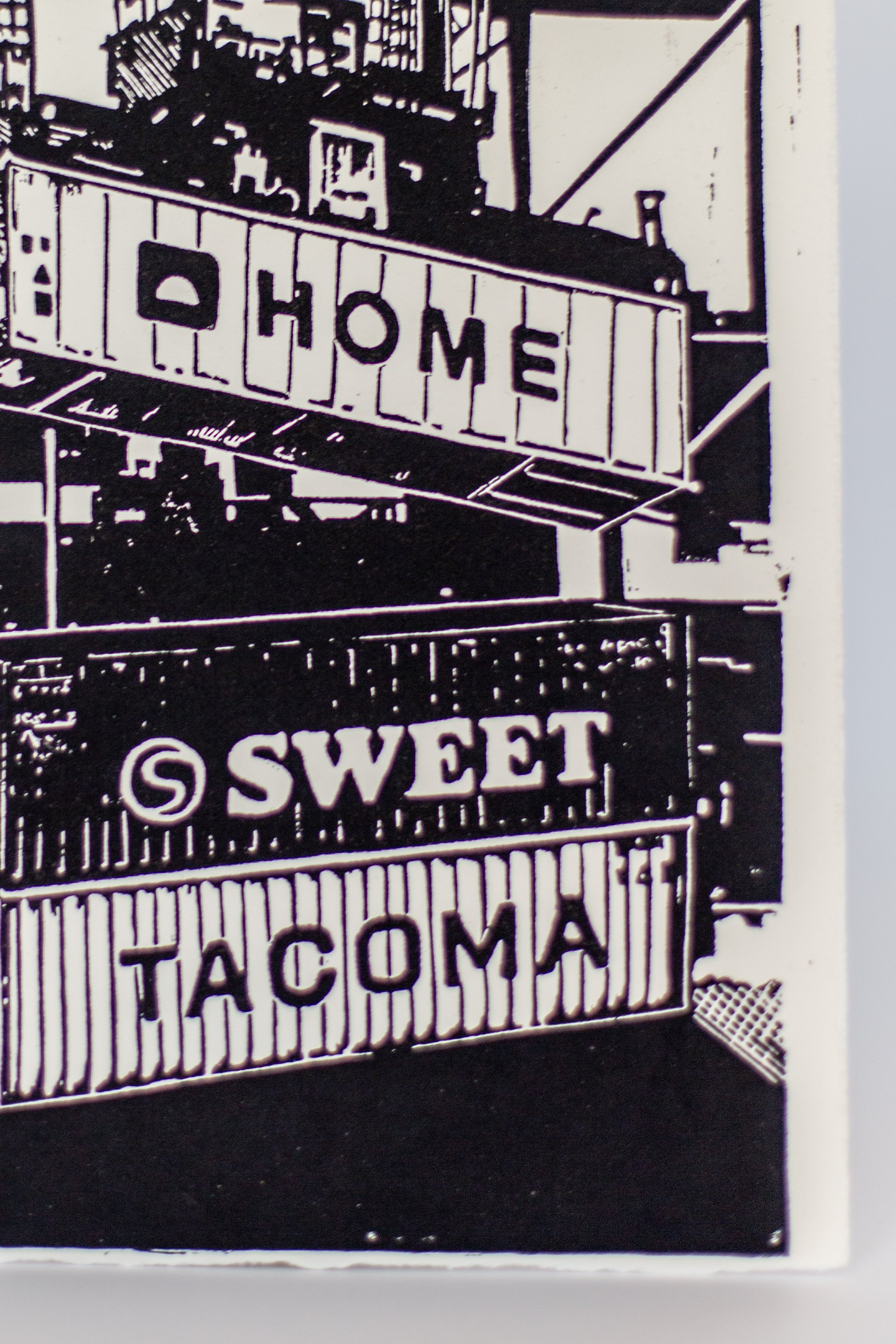Removable Wallpaper Fridge Makeover
Spring 2022 One Room Challenge | Week 3
If you guys know me, you know I can't leave a regular fridge alone. In my last three places I've re-covered my fridge with contact paper. Refrigerators can be ultra boring, and if you're renting, it's not like you can paint it or replace it, so you're stuck with it. Not so! Ladies and gentlemen, removable wallpaper is your fridge's best friend.
I've used chalkboard contact paper, woodgrain contact paper, and marble contact paper, as well as removable peel and stick wallpaper to cover fridges.
What you'll need:
Peel and Stick Wallpaper
Scissors
X-acto knife (optional
Tape Measure
First thing you need to do is remove the fridge door handles, which is very easy. There's usually just a screw on top the door and either on the bottom of the door, or on the bottom front of the door. Unscrew both screws and the handle pops right off. You can screw the handle back on after applying your contact paper, but I liked how clean it looked without the handle and it's perfectly easy to open without a handle.
Applying the removavle wallpaper to the fridge is pretty straightforward. I did two vertical pieces of wallpaper on the front , and then the sides also took two vertical pieces, again, one full width and then a smaller strip to complete the side.
Measure how much you need for each piece as you go, cut the piece and then pull a few inches of the backing off to start applying. Make sure your measurements include enough to wrap around the edges of the doors. Apply it to the front of the door, leaving the edges loose to wrap once you've got the front stuck on. Pull the backing off and smooth the sticky side to the fridge in increments so you don't get air bubbles. Once the front is stuck on, go around the edges and stick them down. You'll need to cut a little slice out of the the corner so it lays flat.
Continue that process around the whole fridge till it's all covered!
Now revel in the awesomeness of your swanky new fridge!
DIY Easy click-connect laminate flooring install
Spring 2022 One Room Challenge | Week 2
There are a lot of nailed-down details on this One Room Challenge remodel, but one thing that was up in the air when I started- the flooring. The original flooring was, well, it was okay. The kitchen/dining/entry area had vinyl plank and the living room was carpeted. It all looked very worn down, and there was a noticeable hump in the floor right as you entered the kitchen.
We needed to decide on the flooring situation ASAP because I didn’t want to paint the cabinets and get those finished nicely and THEN go in and do flooring demo and potentially bang up the new cabinet paint. Since this decision was being made last minute, we also needed flooring that was in stock and available in the quantity we needed to do the entire space— kitchen/dining and the entry/living room.
Well, my parents found some beautiful waterproof laminate flooring at Costco and bought out the whole store (and had to hit up another Costco to get the remaining boxes needed), and we quickly decided to tackle the floors first thing.
Demo was pretty easy, the old vinyl planks came out super easily, and the carpet did as well. Once the flooring was out we were able to figure out what what going on with the lump in the subfloors by the kitchen. The carpeted living room also needed a 1/4in underlayment plywood added to bring that area’s subfloor up to the same level as the floor that had the vinyl planks, which was much easier than fixing the hump.
We ended up pulling out the 1/4in underlayment on either side of the lump, which brought the peak of the hump down lower and we were able to fill in that area with self leveler so the new floors are nice and level with no awkward hump. We ended up needing a couple coats of the self leveler (we didn’t buy enough the first time), so that took a couple days of prep work, which we folded in with prepping the cabinets to prime and paint so there wasn’t any lost time on the cabinet painting front.
I’ve done floating click-connect laminate flooring before in our house, so I had a pretty good idea of what to expect. These kinds of floors are very DIYer friendly. It’s hard to mess up the install, and it’s super straightforward, these were no different. We ended up with Mohawk Waterproof Laminate floors in Millport Hickory. They have the foam under pad attached to the bottom of the plank so you don’t even need to install a pad before going in with the flooring install!
I picked up a laminate flooring install kit from Home Depot, which was exactly what we needed to do the install, and Ryobi had sent over their flooring saw, which came in clutch. I was on cutting duty outside and my brother and Dad were on install inside and we made pretty quick work of the floor!
One thing manufacturers recommend, and I’ll second, is to use planks from different boxes as you work, and to inspect the planks as you install because there are only so many plank designs and you don’t want to end up with identical planks super close to one another. The other thing you’ll want to make sure of is that the gap you leave around the edges of the room (there should be a slight gap to allow for expasion) isn’t too big so that your baseboard trim is able to cover that. We weren’t super careful in a couple spots and had to to some tweaking to make it work.
Ultimately, click-connect laminate flooring is a perfect DIY project. It’s straightforward, relatively easy, and there are so many options out there now for different looks, as well as water-resistant or waterproof planks as well!
10 tools to start on your DIY journey
One of the things that can feel overwhelming when it comes to being a beginner DIYer is not knowing where to start when it comes to those first tool purchases. Whether it’s not knowing which tools to get first, or what brand to go with, or what accessories to get, the world of tools is one that you’ll need to enter in order to have success with your DIYs!
Another big reason it can feel overwhelming: money. Tools cost money! And some of them can be more expensive than others. Don’t feel like you need to run out and buy a whole workshop full of tools right of the bat. You can buy tools slowly, as you need them.
We’ll start with some non-power tools that I always keep on hand, and then we’ll get into the power tools that are essential!
Hammer
This almost feels like it goes without saying! A hammer is one of the most basic tools out there and it’s extremely handy. A hammer is great for everything from putting up shelves and building Ikea furniture, to framing a wall. There are lots of hammers out there, but a basic standard hammer is all you really need (unless you start getting into some more specific building realms). And! They’re very inexpensive.
Tape Measure
”Measure twice, cut once!” and in order to measure twice, you’ll need a Tape Measure. You may want multiple, because if you’re anything like me, you’ll misplace yours and there’s nothing more annoying than not being able to find a tape when you’re working. I also keep a smaller 12 or 16ft tape in my house for easy grabbing, and I’ll usually have a 12ft one in my purse for when I’m out and about and need to measure furniture or stuff at Home Depot. A standard 25ft one is a really great length for having in your toolbox, and is what I have in mine!
Level
A level is super handy and the type you get first may depend on what you’re most wanting to do, DIY-wise. If you’re just installing shelving, hanging pictures, etc— smaller stuff, you may only need a short little level. If you’re leveling counters, floors, or larger projects, you’ll probably want a larger one. I like having a small 1ft level for little things, a more substantial 4ft level, as well as an 8ft one. If you want to get techy and fancy you can also get a laser level, which is a very cool little tool!
Sawhorses
Havinga set of sawhorses, even just some cheap plastic ones, comes in SO handy when you’re working on projects. Cutting wood, making a makeshift table, painting things, sawhorses will help with countless projects and make things 100 times easier.
Power Tools:
Power tools come in two options: corded and battery powered. Typically corded versions are a little more affordable, and they can also be more powerful, but cordless battery operated tools can be more lightweight and convenient. For instance, my battery operated brad nailer is WAY more convenient because I don’t have to hook up my air compressor and pull out the long air hose. I just pick it up and start nailing. My battery operated circular saw is also much lighter and easier to wield than my corded version, but the corded version is more powerful.
Another thing to consider if you start buying battery powered tools is that you’ll want to stick to a brand, only because once you start buying batteries, those batteries will be specific to that brand’s tools and won’t work on another brand. So you don’t want to buy a Ryobi drill and get the battery pack and charger for that and then get a Makita circular saw, because then you’ll have to invest in Makita batteries and charger (and batteries can be expensive!). So stick to one brand, get a few batteries so you can have a spare or two on hand, or charging up so you’ll never get stuck with a tool and a bunch of dead batteries mid-project— that’s the worst!
This obviously doesn’t apply to corded tools since their power source will be the outlet, so you can go “off brand” with those. I use Ryobi for my battery powered tools and I have a few random brands in my corded tools.
Brad Nailer
Having a brad nailer is super handy for a lot of different projects. Working on furniture, installing trim, putting up molding, making shelving, my brad nailer gets a ton of use around my house. There are lots of different nailer types and sizes too, so depending on what projects you think you’re most likely to tackle, you may want a stapler, a pin nailer, a 16 gauge, etc. I LOVE having a battery powered nailer because then I don’t have to have an air compressor with a long air hose dragging through my house in order to work on projects.
Drill + Impact Driver
A drill is one of the most useful and basic power tools you can have in your arsenal. Not only can you drill various size holes with standard drill bits, spade bits, hole bits, and more, you can also use it as a power screw driver. I would say that my drill is my most used tool over the years and if you don’t have any tools at all start with a power drill! An impact driver is very similar to a drill and they look almost identical, but there are some differences. Impact drivers are more lightweight and compact and they also have more torque. While drills hold bits using a “chuck” which is basically a unique way to clamp down on the bit to hold it in place (and you can use standard or hex bits), Impact drivers have a quick change clamp and only take hex bits.
So why/when do you use an impact driver? Impact drivers are more commonly used to drive in a large quantity of fasteners, longer screws and lag bolts. If you use impact-rated, 1/4-inch hex-shank drill bits, you can accomplish some basic drilling tasks with an impact driver. However, these tasks will be limited in scope. An impact driver is not ideal for precision drilling tasks and should be limited to jobs where the size or placement of the hole is not crucial but more torque may be needed, such as drilling through metal and dense or knotty wood.
A lot of time you’ll see these two sold in a set, which is a nice way to get both, but if you can only afford one, go with a standard drill. I will add that driving in screws is much easier with an impact driver, and as a small (yet strong) woman, I have to use much less force to screw in using an impact driver, which is nice.
Circular Saw
The circular saw is an extremely useful tool if you’re doing any kind of building. It’s the first power saw you should add to your toolkit, IMHO. You can make cross cuts, rip cuts, angled cuts, and more. It’s great for cutting plywood, lumber, you can use a blade designed to cut metal, etc. It’s a super handy tool that will instantly level up your DIY. A circular saw can feel intimidating to some, so make time to practice to get the feel for and hang of how it behaves and cuts.
Jig Saw
The one big limitation that a circular saw has is that it can’t make curved cuts. Which is why I highly recommend grabbing a jig saw next. After my circular saw, my jig saw is my most used saw. I love it’s capabilities, and it’s the pervect tool for making more precision cuts.
Sander
Having a power sander on hand is super useful. I use mine all the time. Whether I’m sanding down a piece of furniture to refinish, prepping cabinets to paint, cleaning up cut edges, or smoothing rough surfaces, my sander makes it so easy. There are a few different style of sanders, but for starting out I’d get a sheet sander, or orbital sander, though a corner sander is also a great starter. These styles are great for most basic sanding you’ll be doing.
Spring 2022 One Room Challenge | Week 1
I don’t know if anyone’s been around long enough to remember my last ORC attempt. I fizzled out on my Spring 2020 attempt and my bathroom is still half done, lol. This time— I’ve got a plan of attack and a “client” I can’t ditch out on halfway through. I’ll be making over my brother and sister-in-law’s kitchen/living room!
The main focus will. be the kitchen, but we’re replacing the old flooring throughout the kitchen/living/dining areas since those spaces are open-concept. The current space has carpet in the living quadrant of the space and old, dark, worn-down LVP flooring in the rest of the kitchen/dining. The carpet and LVP are going and we’ll be putting in a lighter wood laminate that will brighten and unite the space.
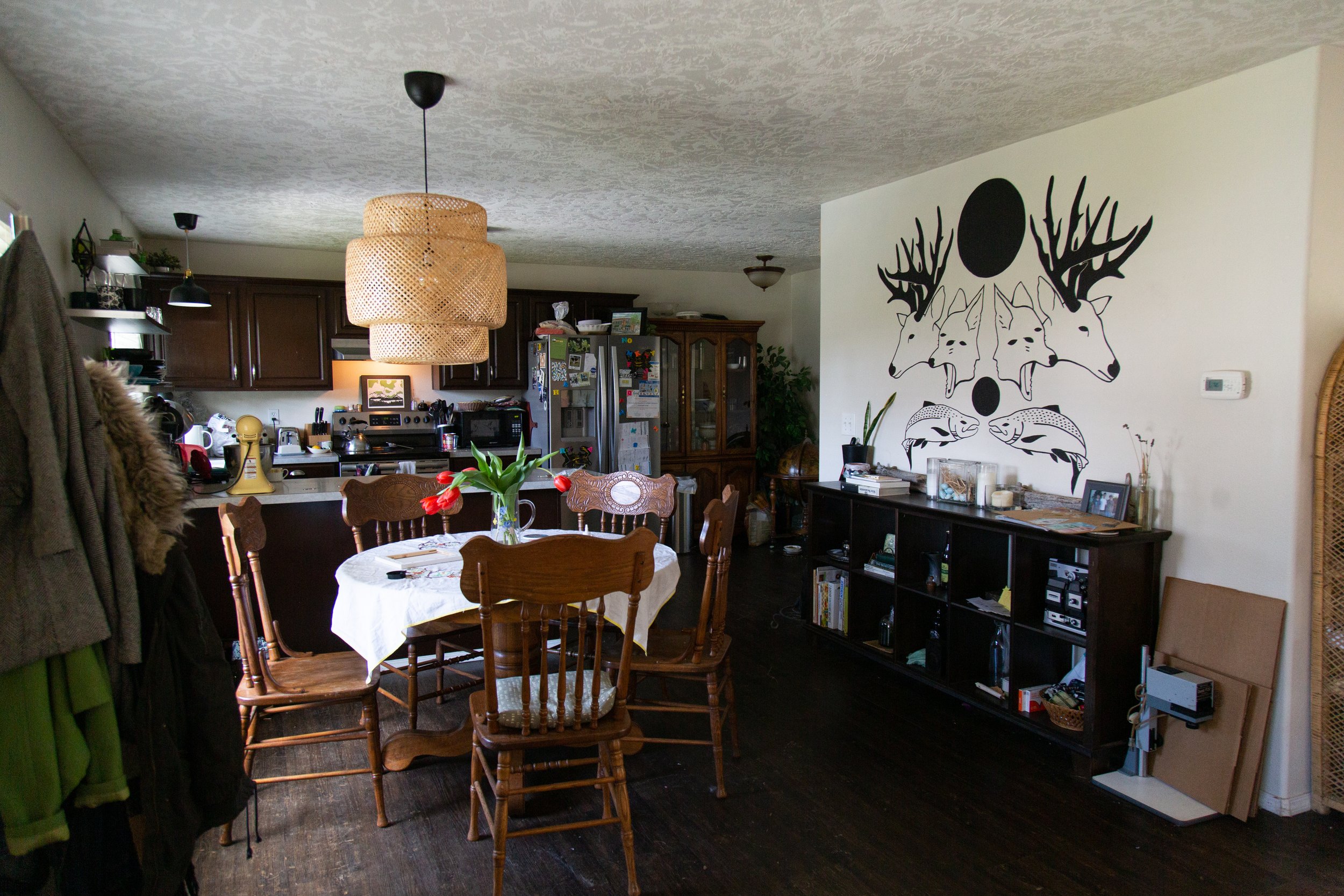
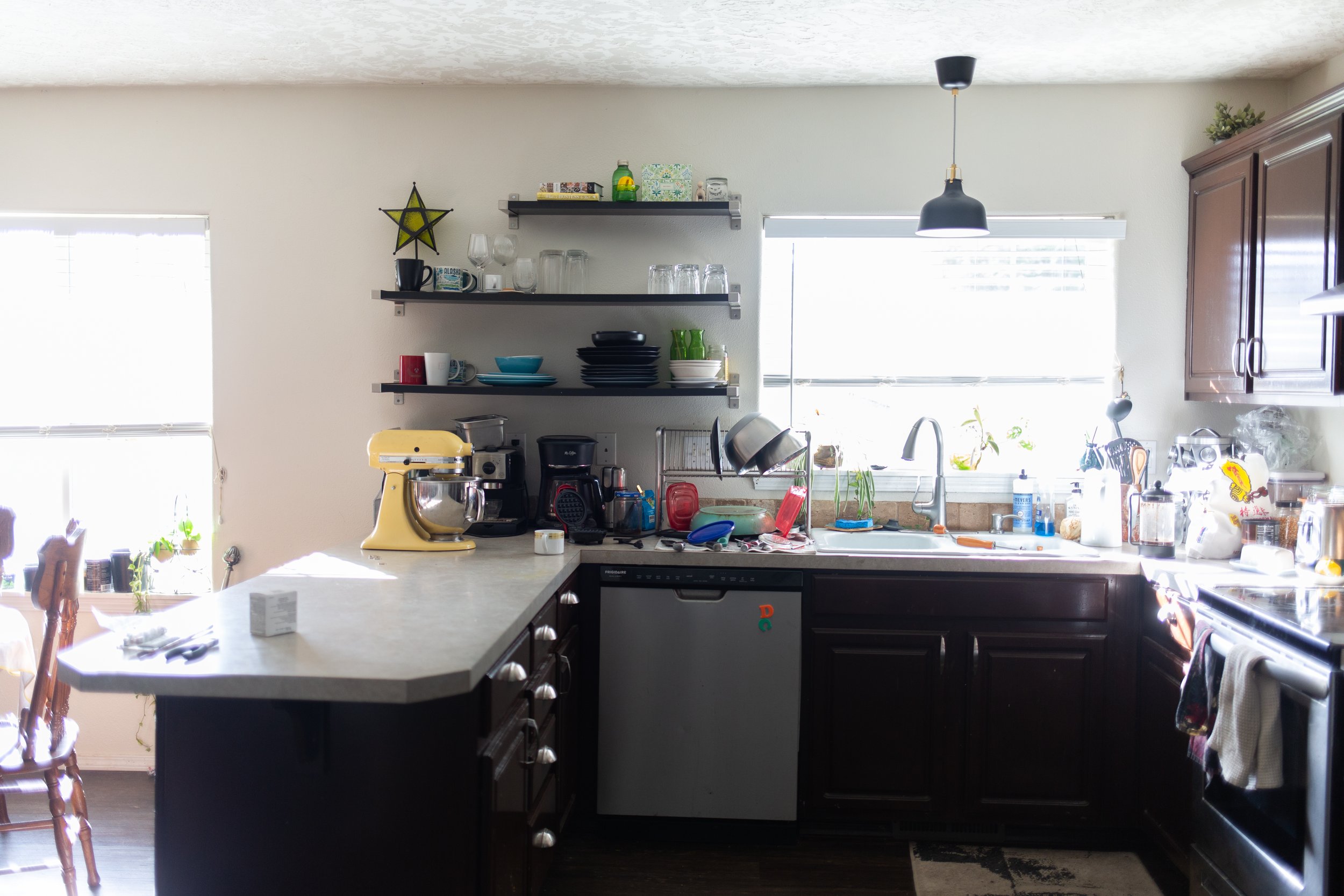
As you can see, the kitchen feels very dark due to the brown cabinets, and what you can’t see is that they are pretty poorly painted. I’m super excited to bring in a rich emerald green onto the cabinets and add some texture and elevate the space with gorgeous white zellige tile on the backsplash. Unsurprisingly I’m also going to be kicking that boob-light to the curb and replacing it with something pretty and refined, and the Ikea pendant over the dining table also isn’t going to be staying.
I like the open shelving to the left of the sink, but I want to replace it with some beautiful wood shelving and brass accents. The countertop is a well worn laminate so that’s going to be replaced with a solid surface quartz countertop. Another fun plan? We’ll be wallpapering the fridge! I had so much fun wallpapering the fridge in the kitchen I did for my BFF last spring, I knew it’d be a fun way to add a graphic element in this space.
We’re already knee-deep in demo and the it-gets-worse-before-it-gets-better phase! Can’t wait to flip this drab, dated kitchen in to an elevated organic-classic space over the next 8 weeks of One Room Challenge!
Hi, I’m Liz
I'm an artist, writer, designer, DIY renovator, and … well basically I like to do all the things. If it’s creative I’m probably doing it. I’ve spent over 30 years voraciously pursuing a life steeped in creativity and I wholeheartedly believe creativity and joy are inextricably linked.
Read more…
Explore The Archive
- January 2025
- December 2024
- August 2024
- July 2024
- May 2024
- April 2024
- January 2024
- December 2023
- October 2023
- September 2023
- July 2023
- June 2023
- May 2023
- April 2023
- March 2023
- February 2023
- January 2023
- December 2022
- November 2022
- October 2022
- August 2022
- June 2022
- May 2022
- April 2022
- March 2022
- November 2021
- October 2021
- August 2021
- July 2021
- May 2021
- January 2021
- November 2020
- October 2020
- September 2020
- August 2020
- July 2020
- June 2020
- May 2020
- April 2020
- February 2020
- January 2020
- November 2019
- October 2019
- August 2019
- July 2019
- June 2019
- May 2019
- April 2019
- February 2019
- January 2019
- December 2018
- November 2018
- October 2018
- September 2018
- August 2018
- July 2018
- June 2018
- May 2018
- April 2018
- February 2018
- January 2018
- November 2017
- September 2017
- August 2017
- July 2017
- June 2017
- May 2017
- April 2017
- March 2017
- February 2017
- January 2017
- December 2016
- November 2016
- October 2016
- September 2016
- August 2016
- June 2016
- May 2016
- April 2016
- March 2016
- February 2016
- January 2016
- December 2015
- November 2015
- October 2015
- September 2015
- August 2015
- July 2015
- June 2015
- May 2015
- April 2015
- March 2015
- February 2015
- January 2015
- December 2014
- November 2014
- October 2014
- September 2014
- August 2014
- July 2014
- June 2014
- May 2014
- April 2014
- March 2014
- February 2014
- January 2014
- December 2013
- November 2013
- October 2013
- September 2013
- August 2013
- July 2013
- June 2013
- May 2013
- April 2013
- March 2013
- February 2013
- January 2013
- December 2012
- November 2012
- October 2012
- September 2012
- August 2012
- July 2012
- June 2012
- May 2012
- April 2012
- March 2012
- February 2012
- January 2012
- December 2011
- November 2011
- October 2011
- September 2011
- August 2011
- July 2011
- June 2011
- May 2011
- April 2011
- March 2011
- February 2011
- January 2011
- December 2010
- November 2010
- October 2010
- September 2010
- August 2010
- July 2010
- June 2010
- May 2010
- April 2010
- March 2010
- February 2010
- January 2010
- December 2009
- November 2009
- October 2009
- September 2009
- August 2009
- July 2009
- June 2009
- May 2009
- April 2009
- March 2009
- February 2009
- January 2009
- December 2008
- November 2008
- October 2008
- September 2008
- August 2008
- July 2008
VISIT THE SHOP
PRIVACY POLICY & DISCLOSURE
We are a participant in the Amazon Services LLC Associates Program, an affiliate advertising program designed to provide a means for us to earn fees by linking to Amazon.com and affiliated sites.








